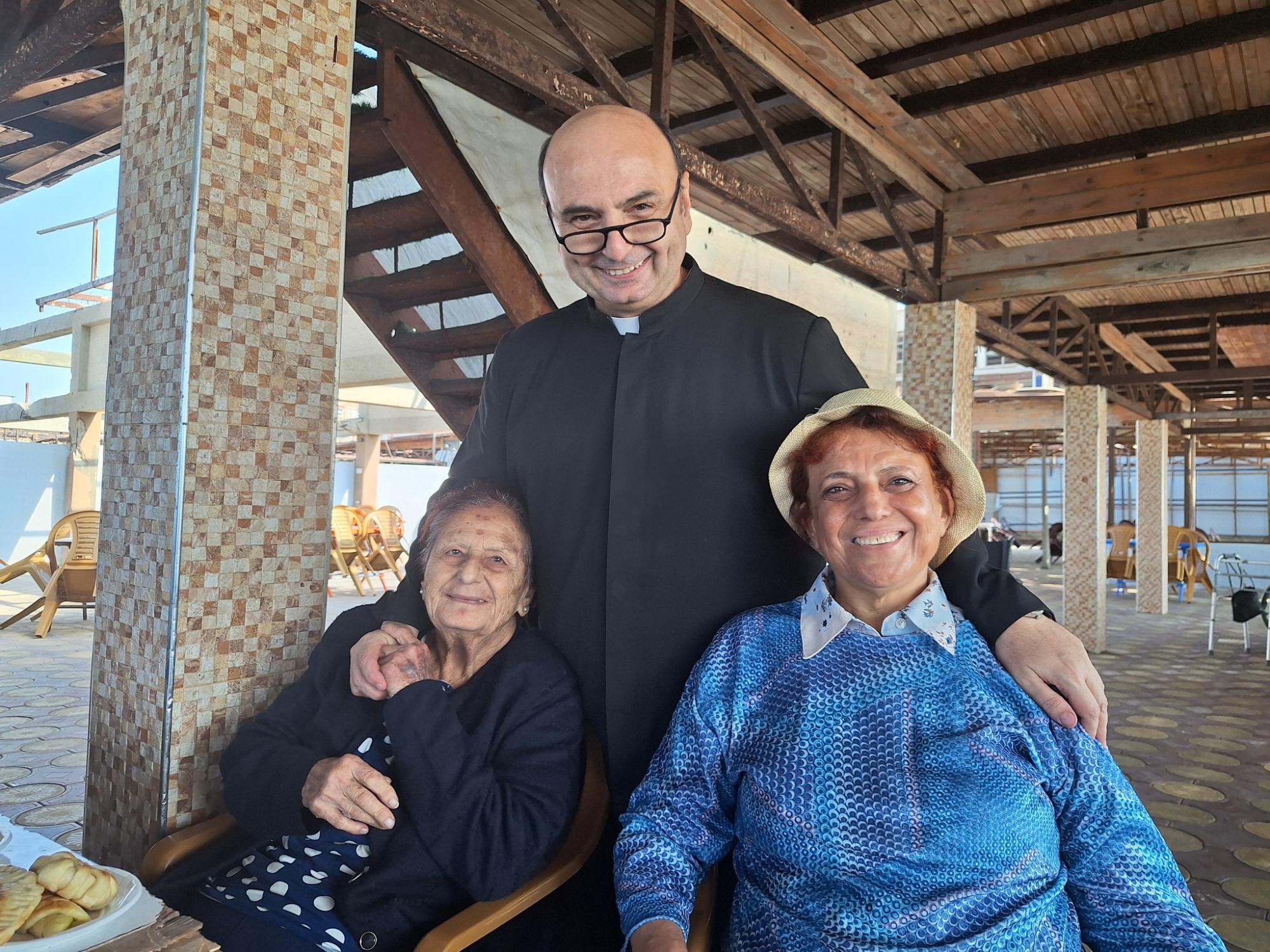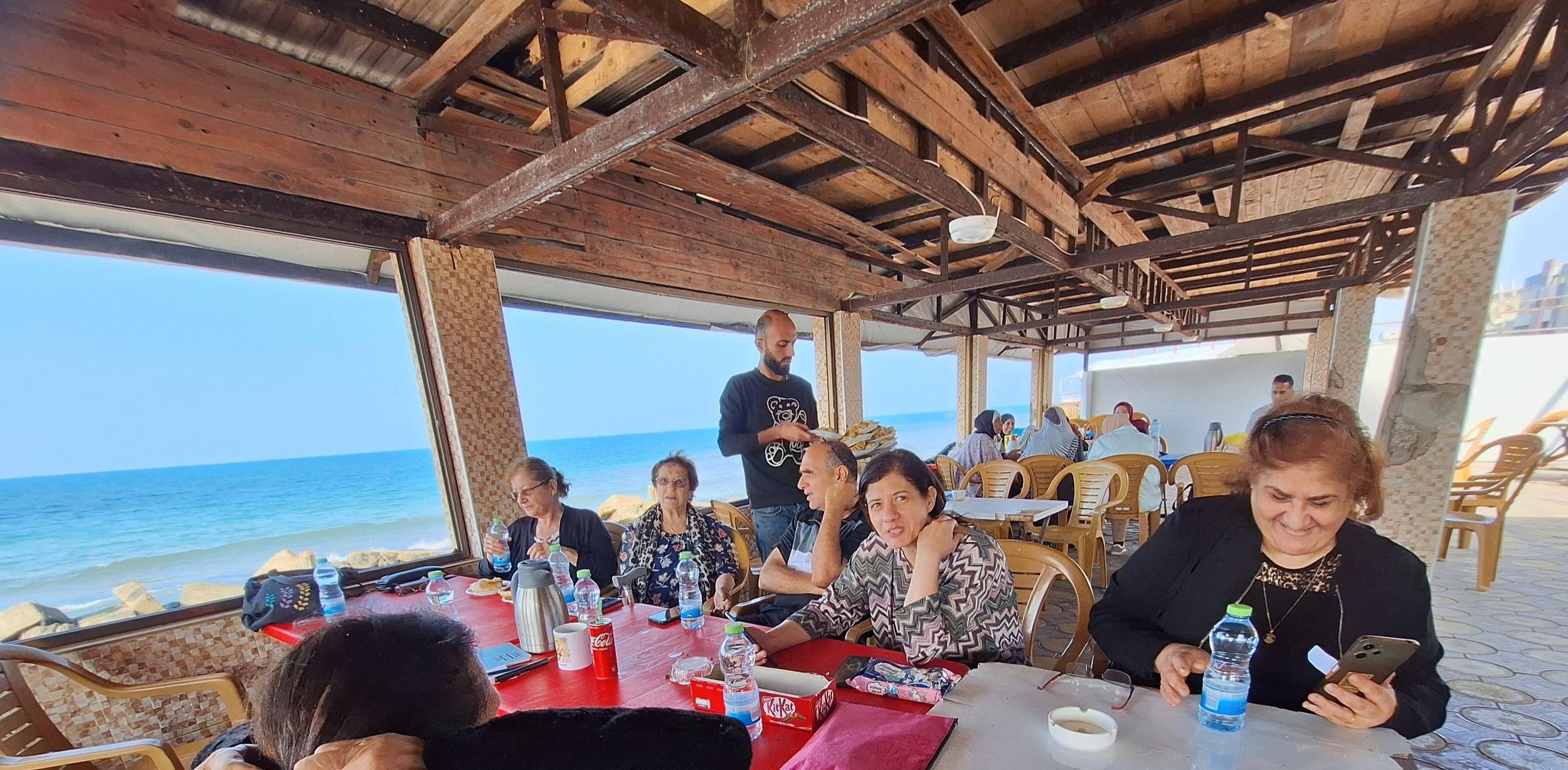
By Sanad Sahelia
Fr. Gabriel Romanelli, parish priest of the Holy Family Latin Church in Gaza, recently shared photos of himself with a group of displaced elderly people on Gaza’s seashore, writing: “With a group of displaced people from the Latin Convent… to see the sea of Gaza. Let us thank the Lord.”
Simple words that hold a deep theology: gratitude in the midst of pain, light in the heart of darkness, and hope as a salvific force that defies despair. In Gaza, faith is measured by its ability to transform suffering into life, and love into witness. Fr. Romanelli teaches that thanksgiving is not a denial of pain, but a declaration that God shares human life—especially in moments of suffering—present in people’s endurance, service, and the hope that blooms amid destruction, creating meaning from wounds and resurrection from ashes.
The experience of the Church in Gaza—through Fr. Romanelli, Fr. Yousef Asaad, and the Nuns of the Incarnate Word—embodies the living theology of the Incarnation at its fullest: God is present in every pain and trial, revealed in every hand that helps, and every heart that chooses to remain with the afflicted. It is a theology of service amid suffering, where faith becomes a tangible act: feeding the hungry, tending to the sick, and sheltering the displaced—even under bombardment and ruin. This experience manifests the theology of daily resurrection and hope: from suffering springs meaning, from rubble rises life. Love proves stronger than fire, and true faith blossoms at the heart of darkness.
In this city weighed down by death, destruction, and hunger, the Church remains a sign of divine presence that cannot be extinguished. Within its cracked walls dwells an unshakable faith that testifies God never abandons the place of wounds, but reveals Himself through them. There, where ashes mingle with prayer, the altar becomes a refuge—not because it guarantees safety from death, but because it bears witness to the resurrection of mission amid nothingness.
In this wounded corner of the Holy Land, in Palestine, the Gospel is incarnated anew: God is known through closeness, sharing, and hope. The Cross, however heavy, remains the path to resurrection—the face of God revealed in human patience and steadfast faith.
When war broke out in October 2023, Fr. Romanelli was outside Gaza and was prevented from returning due to the blockade. Weeks later, he re-entered alongside Cardinal Pierbattista Pizzaballa, Latin Patriarch of Jerusalem, on a rare pastoral visit that restored a sense of safety and hope among the displaced and the wounded. The visit embodied the fatherhood of the Church and the tangible presence of faith amid suffering, while Fr. Romanelli’s return became a symbol of his fidelity to his parish and the Church’s human and spiritual mission in times of trial.
Since his return, Fr. Romanelli has not left the church, which became a refuge for hundreds of displaced Christians and Muslims—among them the sick, the elderly, children, and people with disabilities. He chose to stay with them, sharing danger, hunger, and prayer amid relentless bombardment and severe shortages of food and medicine.
The church compound itself has not been spared Israeli attacks. Since October 2023, it has been repeatedly targeted by shelling and sniper fire, resulting in casualties within its courtyard—including elderly women who had sought refuge there. The latest attack occurred on July 17, 2025, when a shell struck the compound as hundreds of displaced persons sheltered inside. Three people were killed and dozens wounded, among them Fr. Romanelli, injured while trying to rescue those trapped under the rubble. Yet the priests and sisters continued their daily service—praying, tending to the wounded, and bearing living witness that love is stronger than death, and that faith blossoms in the heart of pain.
Through this tragic experience, the deepest meaning of the mystery of the Incarnation is revealed in the Church’s life: God does not remain distant from suffering but descends into human reality to share it fully. In Gaza, Christ is manifested in every hand that extends water, food, medicine, and care; in every prayer whispered by candlelight; and in every priest and nun who choose to stay with those who have no voice—carrying the Gospel into the heart of human agony, turning faith into living service that radiates hope in the darkness.
Here, the Church’s spiritual and liturgical mission becomes incarnate in the lives of the people. The Church becomes the living Body of Christ within reality itself, bearing witness that faith is not an escape from pain but a committed presence within it—where the Gospel is translated into daily acts of service. The Church does not merely proclaim peace; it plants it with wounded hands.
As the Gospel says: “I was hungry and you gave me food; I was thirsty and you gave me drink; I was a stranger and you welcomed me; I was sick and you visited me.”
This is how Fr. Gabriel Romanelli and his companions live the essence of the Gospel in Gaza: in the midst of bombing and death, they sow the seeds of life, transforming pain into acts of love and service. In the Holy Family Parish, resurrection is lived daily—not as a distant memory, but as a living experience born from deep wounds, bearing witness to unbroken faith. And from there, the divine word resounds anew: “Peace I leave with you; my peace I give to you. I do not give to you as the world gives.”
Thus, peace in Gaza becomes a tangible reality—crafted through love and endurance, not proclaimed in words but embodied in every helping hand and every heart that chooses hope.

